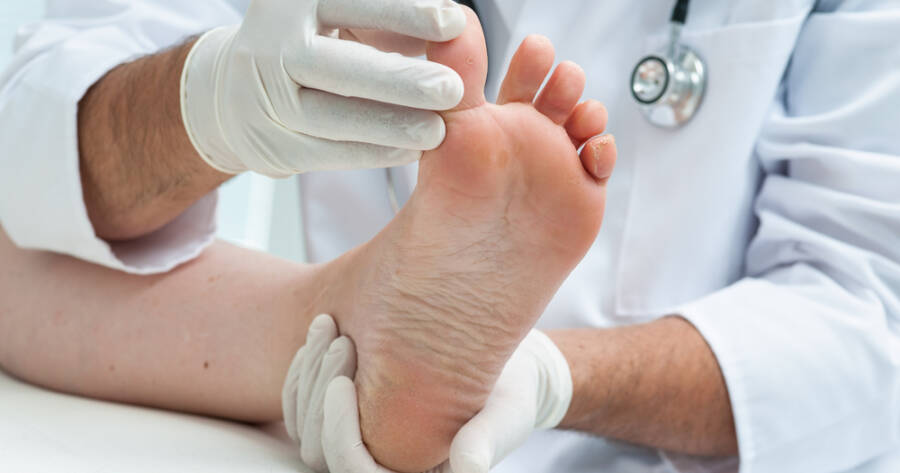Nail fungus, a common infection of the nails, can be treated with over-the-counter or prescription medications. For severe or persistent cases, consulting a podiatrist is recommended. Proper hygiene, such as keeping nails dry and trimming them regularly, can help prevent reinfection. In some cases, laser therapy may be used to target the fungus beneath the nail. Early treatment is key to preventing further damage and improving the overall appearance of the affected nails.
What is Nail Fungus?
Nail fungus, also known as onychomycosis, is a common fungal infection of the nails. It can affect both fingernails and toenails, and is caused by a variety of fungi, including dermatophytes, yeasts, and molds. Nail fungus is not typically serious, but it can be unsightly and difficult to treat. In some cases, it can also lead to more serious problems, such as bacterial infections or permanent damage to the nail.1
Nail fungus is spread through direct contact with an infected person or animal, or by contact with contaminated surfaces. It is more common in people with weakened immune systems, such as those with diabetes or HIV/AIDS. Other risk factors for nail fungus include: advancing age, excessive sweating, and trauma to the nail.
Symptoms of nail fungus can include:
- thickening of the nail
- discoloration of the nail (usually yellow or brown)
- brittleness of the nail
- separation of the nail from the nail bed.
How to Treat Nail Fungus
There are a variety of treatments for nail fungus, including over-the-counter medications, prescription medications, and laser therapy. Over-the-counter medications for nail fungus are typically topical creams or ointments that contain antifungal ingredients. Prescription medications for nail fungus are typically oral antifungal medications that are taken by mouth. Laser therapy for nail fungus is a relatively new treatment that uses lasers to kill the fungus.
The best treatment for nail fungus depends on the severity of the infection and the underlying cause. In some cases, a combination of treatments may be necessary. Treatment for nail fungus can be lengthy, and it may take several months or even years to completely clear the infection. If you have nail fungus, it is important to see a doctor to get a proper diagnosis and treatment plan. Self-treating nail fungus can be ineffective and may lead to complications.
Preventing Nail Fungus
There are a number of things you can do to help prevent nail fungus, including: keeping your feet dry and clean, avoiding walking barefoot in public areas, wearing shoes that fit well, and trimming your nails straight across. You should also avoid sharing nail clippers or other personal items with someone who has nail fungus.2
If you have a history of nail fungus, you may want to take additional precautions to prevent reinfection. These precautions include: using antifungal soap or body wash, wearing antifungal socks, and avoiding contact with known sources of fungus.
Risk Factors for Nail Fungus
Certain individuals are more prone to developing nail fungus due to various risk factors. Age plays a significant role, as older adults are more susceptible to nail infections due to reduced blood circulation and slower nail growth. Additionally, people with weakened immune systems, such as those with diabetes, HIV/AIDS, or those undergoing immunosuppressive treatments, are at an increased risk.
Environmental factors like frequent exposure to damp, warm environments, such as swimming pools or communal showers, also contribute to the likelihood of developing nail fungus. Understanding these risk factors can help in preventing the onset of the infection by taking appropriate precautions.
Natural Remedies and Home Care
While conventional treatments like antifungal medications and laser therapy are commonly recommended, some individuals prefer natural remedies to combat nail fungus. Tea tree oil, for example, is a popular home remedy known for its antifungal properties. Other options include soaking the affected nails in a diluted vinegar solution or applying coconut oil to the area.
Though these remedies are generally considered safe, it’s important to note that they may not be as effective as medical treatments. Combining natural remedies with proper hygiene practices, such as keeping the nails clean and dry, can enhance their effectiveness. Always consult a healthcare provider before attempting any home treatment to ensure it won’t interfere with other medical treatments.
When to Seek Professional Help
While mild cases of nail fungus can sometimes be managed at home, it is crucial to know when to seek professional help. If the infection persists despite over-the-counter treatments or natural remedies, or if the nail shows signs of severe discoloration, thickening, or detachment from the nail bed, consulting a podiatrist or dermatologist is essential.
Finally, if you experience pain, swelling, or signs of a secondary bacterial infection, such as redness and warmth around the nail, immediate medical attention is required. Timely intervention by a healthcare professional can prevent the infection from worsening and causing permanent damage to the nails.
Learn More About Nail Fungus
Nail fungus is a common but often stubborn infection that can affect both fingernails and toenails. While over-the-counter treatments, prescription medications, and even natural remedies can help, the severity of the infection often dictates the best course of action.
Preventative measures, such as maintaining good hygiene and avoiding known risk factors, are essential for keeping nail fungus at bay. If symptoms persist or worsen, seeking professional medical advice is critical to prevent complications and ensure proper treatment. With early intervention and the right care, nail fungus can be effectively managed and, in many cases, fully resolved.
